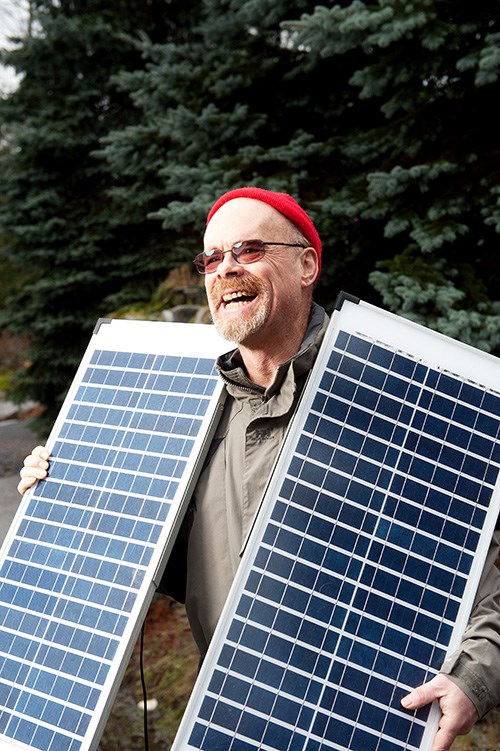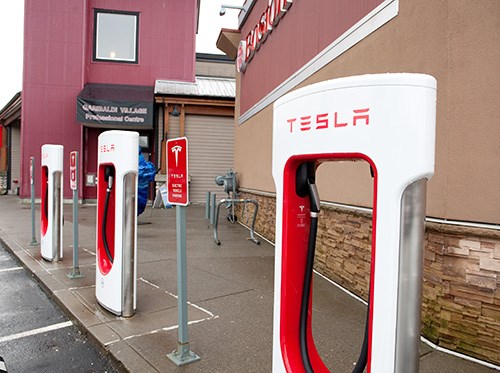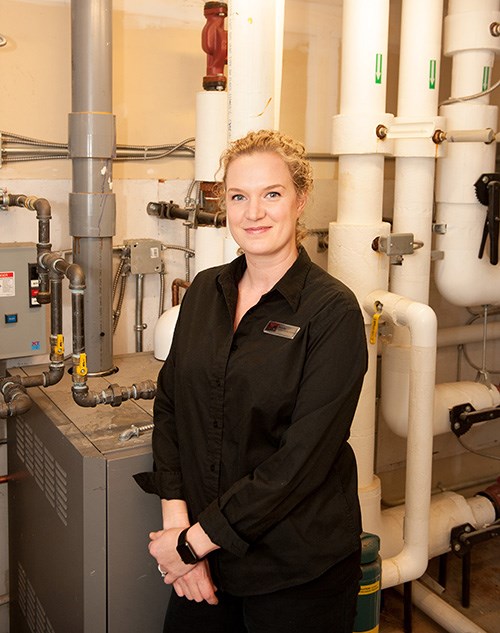Over 10 years ago, the District of �鶹�����initiated a pilot program to look into the feasibility of placing wind turbines in strategic areas to generate green energy.
They discovered it wouldn’t work. However, the quest for green energy solutions in the community did not die.
Take for example Diamond Head Motors, who on their own initiative (and expense) built one of the largest commercial solar projects in B.C.
“Our goal is net zero. The system was installed in mid-November, so we won’t know if we’ve accomplished that until we complete a full year cycle,” said project manager, Sharlene Raffael.
“Ideally we’ll overproduce in the summer, and make up for the darker winter months,” although she stressed, even on dark grey winter days they still produce solar energy. Only when the panels are covered by snow does energy production go to zero.
“It was a substantial project, with a price tag to match, but over time it will pay off, both for us and for the community,” said Raffael.

Matt Blackman, the founder of �鶹�����Alternate Energy Group, hopes to see projects like the one built by Diamond Head Motors become the rule, not the exception. He created his organization in 2014 with the goal of making �鶹�����the fifth solar city in Canada. To reach that designation, Blackman said 10 criteria must be met, including a solar energy demonstration project and awareness-raising initiatives from the municipality on how residents can build scalable solar energy for their homes.
In 2016, �鶹�����did indeed become Canada’s fifth ‘solar city,’ however, says Blackman, the real work is just beginning.
“The previous provincial government didn’t do much to encourage the use of solar energy technology, and that hasn’t changed much under the NDP.”
Blackman says he’d like to see the province do what Alberta and Manitoba have done and provide incentives for homeowners to invest in solar energy. “The costs are coming down, and solar energy is improving.” Although, locally Blackman says there’s still a lot of work to do on just raising awareness. “We have over 700 members now, which is great, but still, it’s a drop in the bucket compared to the overall population of Squamish.”
His organization is not strictly about promoting solar energy, Blackman is pushing for more electric charge stations for cars, saying without the infrastructure in place, electric car sales will be limited. “It’s a bit of a chicken and egg thing.”
According to Blackman, electric cars are five times more efficient than internal combustion engines.
A gallon of gas holds 30 kilowatts of electricity, and an electric car can get roughly 110 miles on 30 kilowatts, he says.
“There’s a bit of a bottleneck in battery technology, but really disruptive battery technology is five to 10 years away,” he said.
“When that happens why would you buy anything but an electric car? So in terms of infrastructure, we want to be ahead of that.”
Eric Andersen, of the environmental group, �鶹�����CAN, agrees that other jurisdictions are making much greater progress in promoting electric cars, but he feels the push for electric vehicles will mainly come about organically as gas prices rise.
Although, as he says, getting people to Whistler and Vancouver continues to be the most significant source of carbon, a comprehensive transportation strategy, still seems elusive.
“We [�鶹�����Can] participate with the Chamber, the District and others on transportation strategy, and we recently had a presentation from �鶹�����Commuter Service to get information on the challenges they face,” he said.
On the other hand, says Anderson, there is a lot of positive work being done locally on residential and commercial uses of energy.
For example, homes have been added to the Eco Home Hop — a showcase of energy- efficient homes in Squamish; there was also a collaboration with Quest University on a solar water heater, which is a well-proven system.
There has also been solar electricity installations, geothermal heat exchange, and building envelopes that are up to the passive house standard, and energy star homes, or, passive plus.
These are some of the only homes like this in Canada, with prefab, energy efficient wall systems, says Andersen.
“There’s certainly opportunity to expand passive design to commercial and institutional buildings, perhaps the forestry centre. Currently, it’s just several residential buildings,” he said.
But says Andersen, there’s much more that can be done locally to promote better use of energy and resources.
“There needs to be a reinvigorated energy policy at the provincial level, as right now our pulp mills are being paid not to produce electricity. We have a problem with our organic waste stream, which after transportation is one of the largest carbon emitters,” he said.
It may seem counterintuitive to low carbon goals, but using organic waste, in combustion, can reduce greenhouse gases.
“Biowaste generation, gasification, combustion, different technologies, that needs to be established, it does involve a lot of capital, but we have lot of organic waste here,” said Andersen. “Landfill involves methane, which is a very potent greenhouse gas, and we have acres of buried wood waste, far better to turn that waste into useful energy products.”
Mayor Patricia Heintzman says the District has started the first phase of reducing organic waste off-gassing, again, it may seem counterintuitive, but capturing the gas, and flaring it off is better than the alternative, she says.
“Burning off methane, then letting it excrete reduces carbon output by one to two thousand tonnes per year,” said the mayor. Adding that like Andersen and others, the District would like to find an end user for that captured gas, that could then convert it into energy. “That’s a long-term project, maybe it could get started a year from now or four years, but being able to capture that gas is the first step, and flaring off the gas at least gets an immediate reduction,” she said.
The District also has its Community Carbon Marketplace, an initiative to get muni operations to net zero emissions.
“All municipalities in B.C have signed onto the Climate Action Plan; operations have to be carbon neutral. The number we’ve put on the price of carbon is $30 per tonne, so we have a number of programs to reduce our footprint, but it’s almost impossible to reduce our carbon output to zero. There are still about 800 to 1000 tonnes, so the question is do we purchase carbon offsets?”
Heintzman said she, and many at the District were concerned about the validity of buying carbon offsets from overseas countries, that may have little oversight.
“So we set up our own carbon marketplace, which allows us to put $30-40K back into the local community. This then becomes an economic development program as well as raise awareness on carbon reduction, while allowing the District to meet its goal of carbon neutrality.”
The Mayor explained that the District works with the Cowichan Energy Alternative Society, which first established an evaluation template for the town of Duncan. “
Right from the start eight-ten businesses qualified or were close, according to Heintzman. The West Coast Heritage Railway Park was one, thanks to their geothermal heat exchange, she added.
In other areas, the mayor acknowledged, she’d like to see more progress, for example, solar panels. “We’ve done a little, although not as much as we’d like to.”
One of the things in the OCP vision is that all new District buildings be LEED (Leadership in Energy and Environmental Design) standard or a comparable standard, Heintzman said.





